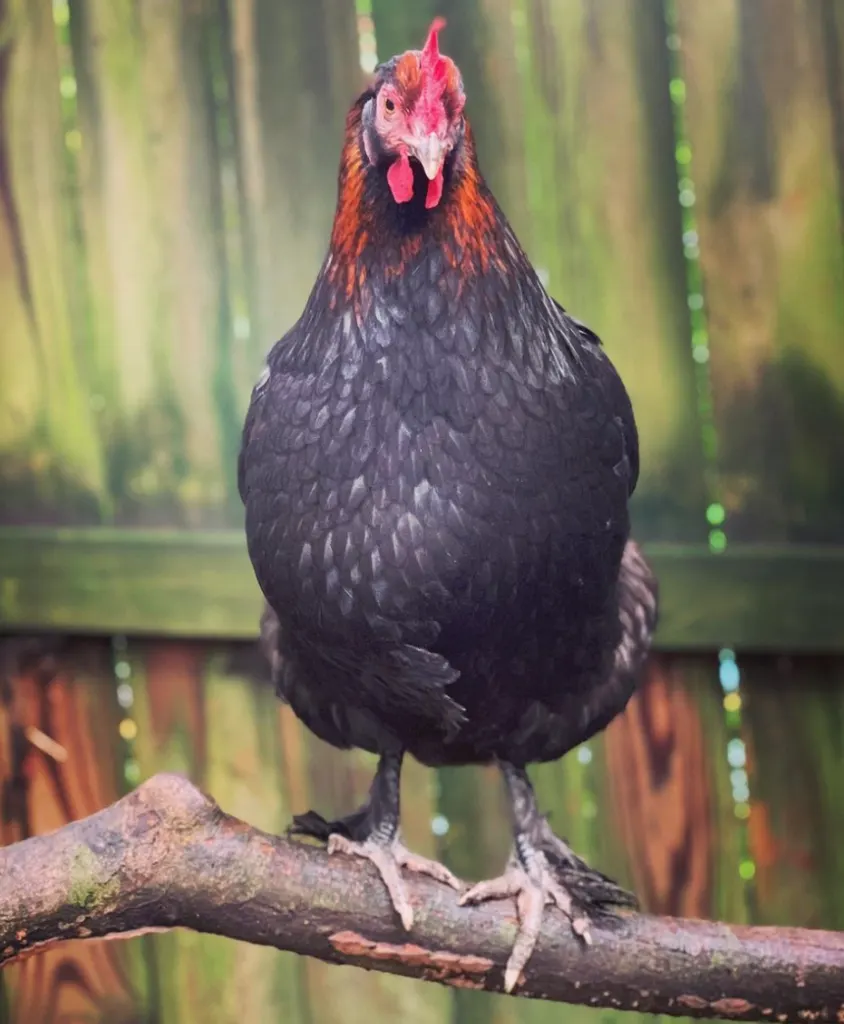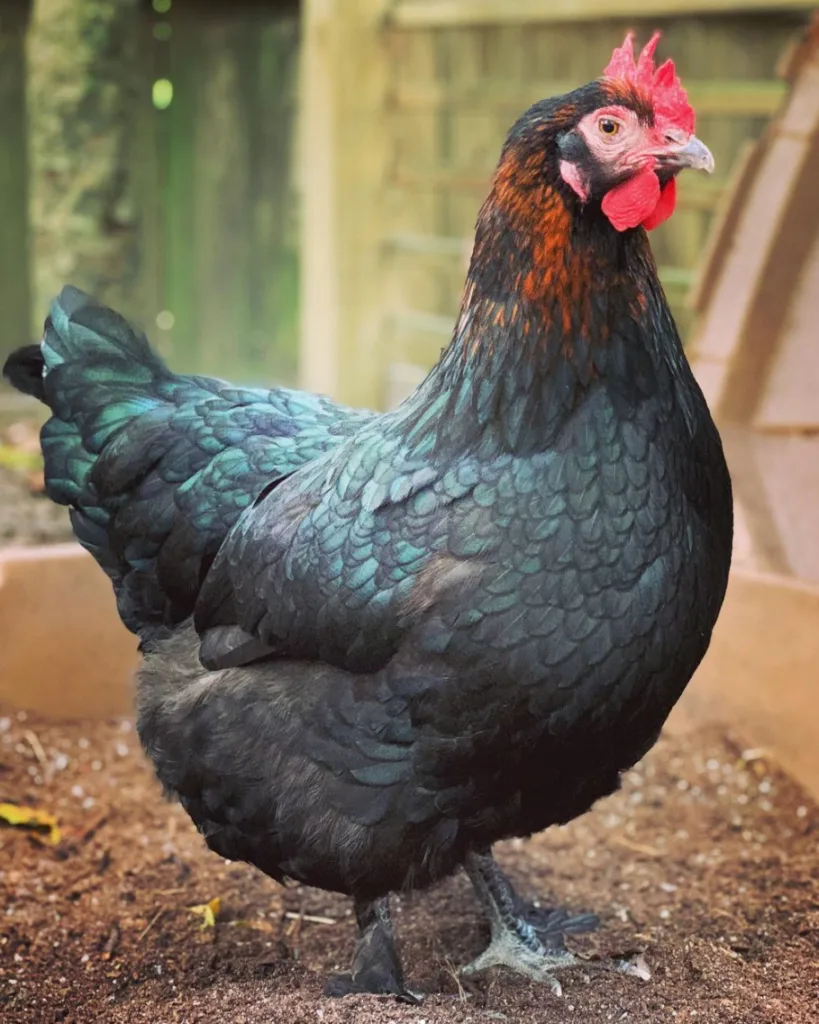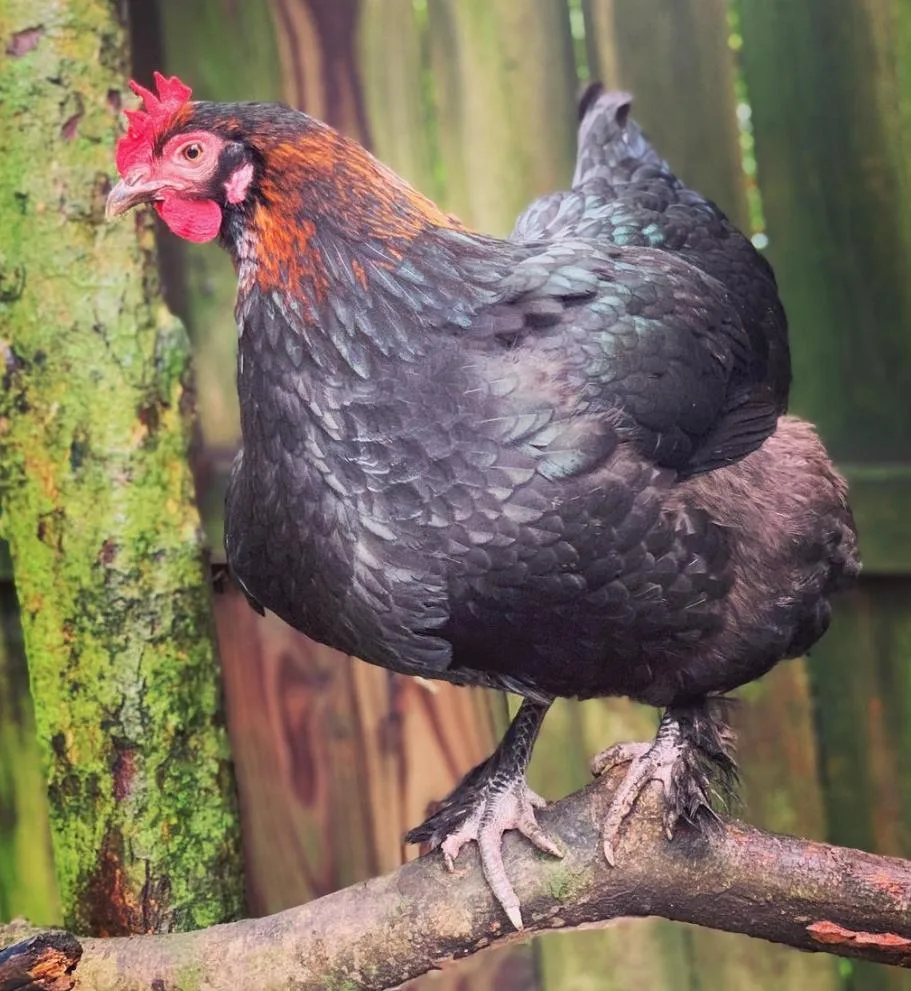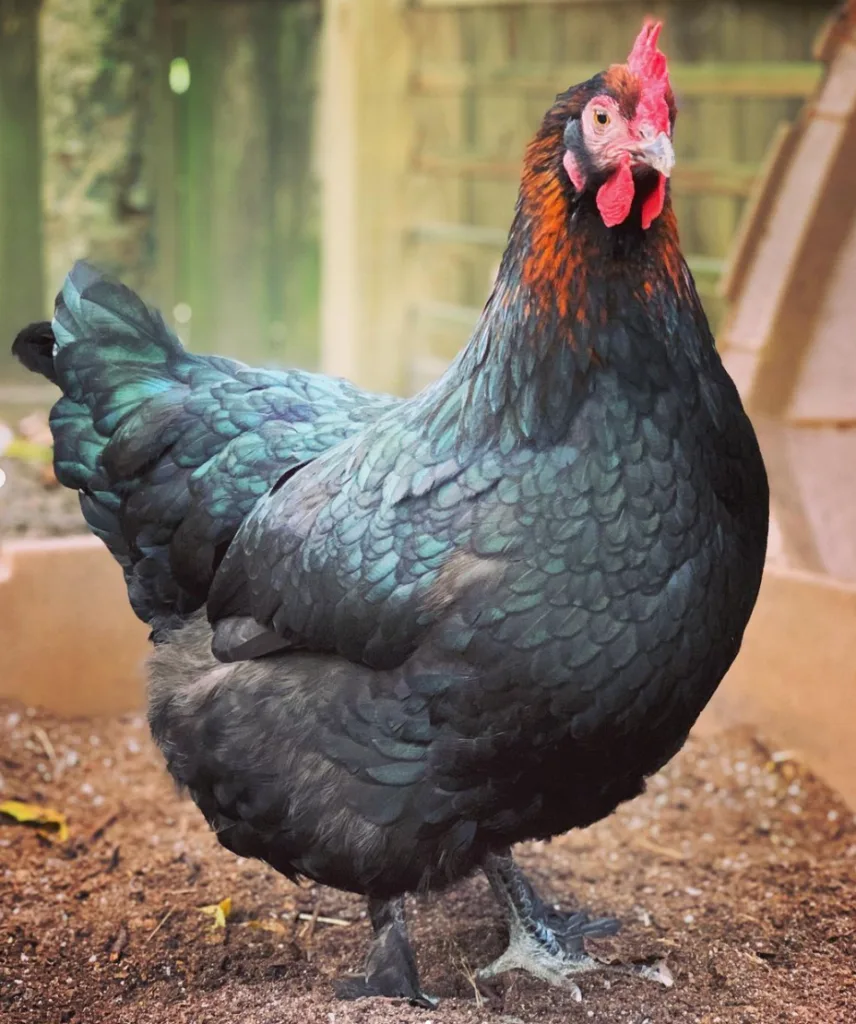Black Copper Marans are a unique breed of chicken known for their egg production, striking appearance, and robust health.
Originally from the Marans region of France, these chickens have a rich history that contributes to their appeal.
Not to mention, they have stunning black and copper plumage that sets them apart from other breeds.
Despite being a somewhat rare breed, Black Copper Marans have started to gain popularity among backyard poultry keepers and hobbyists in recent years.
Their distinct egg color, attractive appearance, and their adaptability make them a desirable addition to any flock.
In this article, we will discuss:
- An overview and history of Black Copper Marans
- Appearance and other characteristics of this breed
- Black Copper Maran egg production and laying capabilities
- Common healthcare for this breed
- Some frequently asked questions

Black Copper Maran Overview
| Lifespan | 5-8 years |
| Weight | Hen: 6.5-7.5 lbs, Rooster: 7-8 lbs |
| Appearance | Deep black body feathers with copper back and neck feathers |
| Egg Color | Dark, rich brown |
| Egg Size | Large |
| Egg Production | 150-200 per year (~3 per week) |
| Broodiness | Medium |
| Beginner Friendly | Yes |
| Space Needed | 4 square feet per bird inside the coop, 8-10 square feet each outdoors |
| Price | $30-$60 per chick |
The Rich History of Black Copper Marans
The Marans breed, also known as “poule de Marans”, originated in the marshy regions of Western France, near the port town of Marans.
Originally known as ‘swamp chickens’, these birds were initially the result of local landrace birds crossbreeding with hens and roosters from India and Indonesia that were brought over by sailors.
The resulting breed was a hardy, dual-purpose bird highly esteemed for its egg-laying capabilities and meat quality.
In 1921, a breeding program initiated by Mrs. Rousseau sought to unify the breed’s plumage, leading to the creation of the Cuckoo Marans, a variety still popular today.
By 1932, the French Department of Agriculture recognized six varieties of Marans – Silver Cuckoo, Black Copper Neck, Ermine, Red, White/ Black, and Golden Cuckoo.
However, post-war France saw the breed’s numbers dwindling, pushing the French Department of Agriculture to launch a breeding program to save the breed from the brink of extinction.
Today, the Black Copper Marans is one of the most sought-after varieties, admired for its dark egg color, striking silver cuckoo pattern, and golden cuckoo variations.

The Appearance and Characteristics of Black Copper Marans
The Black Copper Marans are a beautiful black chicken breed known for their black and copper plumage and robust physique.
They are a medium-to-large breed, with hens weighing around 6.5 to 7.5 pounds and roosters weighing up to 8 pounds.
This breed can come in bantam size, however, they are very rare, expensive, and difficult to find.
Their body feathers are a deep black color that can have an iridescent look in direct sunlight, while their neck and back colors range from black to copper.
Black Copper Maran males often showcase more copper coloration on their neck and back feathers than the females.
Breed Standard of Black Copper Marans
The American Poultry Association (APA) recently recognized Black Copper Marans in 2011.
However, the breed standard for Black Copper Marans was set by the Poultry Club of Great Britain in 1935.
The standards for this breed vary from country to country.
In the US, these birds must have clean legs (or very thinly distributed leg feathers).
The breed standard also specifies that these birds have a black body with copper-red colored feathers on their hackles.
One of the most striking breed standards is their egg color.
Black Copper Maran eggs are known for their deep, chocolate-brown color, a characteristic that sets them apart from other egg-laying breeds.
Color Variations of Maran Chickens
The Marans breed, originating from the port city of Marans in France, is well-known for its variety of color patterns.
The Black Copper Marans is one of the most popular variations, characterized by its copper-colored neck and predominantly black body.
However, the breed offers more than just this distinctive color variation.
Marans chickens, being a dual-purpose breed, also come in other colors such as Silver Cuckoo, Golden Cuckoo, and White Marans.
Each color variation has its unique charm, but all share similar physical traits such as feathered legs and toes, making them easily identifiable as part of the Marans breed.
Size and Physical Attributes of the Breed
Black Copper Marans are medium to large-sized chickens.
On average, a mature rooster can weigh up to 8 pounds, while hens weigh around 6.5 pounds.
This breed is known for its sturdy body, with broad shoulders and a well-rounded chest.
One of the most striking features of a Black Copper Maran is its deep black plumage, which often has a green iridescence under direct light.
This green iridescence, combined with their rich copper neck feathers and feathered legs, gives the Black Copper Marans a unique and attractive appearance among chicken breeds.

Black Copper Maran Temperament and Behavior
Black Copper Marans are known for having a variety of different personalities.
These birds can either be feisty, aggressive, or confrontational, or they can be docile and calm backyard chickens.
Their bad temperament is due to their background of gamecock fighting genes, although most modern hatcheries ensure that their birds are friendly and docile.
Black Copper Marans chickens tend to be more self-sufficient, preferring to forage on their own rather than depend on human interaction.
This breed is not particularly known for being overly affectionate or friendly, but they are generally easy to handle and are not typically known to be aggressive towards humans.
And despite their independence, they do well in a flock, showing no significant aggressive tendencies towards other chickens.
Egg Laying, Color, & Production
Black Copper Marans have decent egg-laying capabilities and are known for their distinctive egg color.
Compared to the typical white or brown eggs, Black Copper Maran eggs stand out with their darker, chocolate-brown shells.
Some Black Copper Maran eggs will even have dark, pigmented speckles on them, making them a great addition to any kitchen counter.
An interesting fact about their egg color is that the fewer eggs a Copper Maran hen lays, the darker the color they will be.
This is because the pigment overlay on the egg is a finite resource, and as it starts to get low, the color gets lighter.
A healthy hen can lay between 150-200 eggs per year, however, it is typically closer to 150 per year.
In addition to their beautiful egg color, Black Copper Maran eggs are also highly sought after due to their rich flavor and yolks.
Black Copper Marans Healthcare
Black Copper Marans are hardy birds and they adapt well to different climates and show resilience against common poultry diseases.
However, just like with any livestock, they can be susceptible to common poultry diseases such as lice or mites, egg-laying issues, and injuries.
Regular health checks and preventative measures are key to ensuring the wellness of these birds.
Dietary balance, cleanliness of the coop, and routine vaccinations contribute to their overall health.
It is also important to note that Black Copper Marans, as with the other recognized varieties of Marans, are a hardy breed capable of thriving in different environments.
As long as they are not introduced to extreme heat or cold weather, they should thrive in most environments.
Also, whether raised in a backyard coop or a farm setting, these chickens are capable of adapting and maintaining their health.
Their robustness and adaptability contribute to their reputation as a low-maintenance and resilient breed.
Tips for Raising Healthy Black Copper Marans
When raising Black Copper Marans, it is crucial to prioritize selective breeding.
This breed is still in its developmental stages, and careful selection of birds to pass on their genes can contribute to the refinement and improvement of the lineage.
The color of their eggs, which is a distinguishing feature of the breed, can change over time.
Thus, it is advisable not to solely rely on photos when choosing your Marans chicks.
Providing ample space per bird and encouraging exercise is another critical aspect of raising healthy Marans.
When kept in close quarters, these chickens have a tendency to gain excessive weight, which can lead to health complications.
Ensuring they have enough space to move around freely can help maintain their physical condition and overall well-being.

Why Are Black Copper Marans so Expensive?
The cost of Black Copper Marans can vary considerably, largely dependent on the quality of the bird.
While the upfront cost for hatchery birds can be under $10 each, birds from quality breeders can cost anywhere from $30 to $60 per bird.
Even hatching eggs can range from $75-$100 depending on the hatchery.
Several factors contribute to the pricing of Black Copper Marans.
One key factor of the price for these birds is the bird’s quality, which is often a result of careful selective breeding.
Birds from quality breeders, characterized by their beautifully colored plumage and muscular build, are typically higher in price.
Additionally, the color of their eggs is another distinguishing feature of the breed, and can also impact pricing.
The deep, dark brown color of their eggs and their flavorful, creamy yolk is typically highly sought after by a lot of chicken keepers.
Lastly, the breed’s adaptability to varying climates is another reason for the high price tag.
In colder climates, special care needs to be taken of their large combs, which stand tall and far off the head of the rooster.
This susceptibility to weather conditions can impact the cost of maintaining the birds, affecting their price.
Despite the cost, many poultry enthusiasts consider the price worth it, given the breed’s unique characteristics, such as the rich color of their eggs, and their robust health.
Pros and Cons of Raising Black Copper Marans
There are several benefits to raising Black Copper Marans, however, there are also some challenges to consider.
In this section, we will discuss some of the pros and cons to owning and raising Black Copper Marans.
Pros
Beautiful back plumage, making them stand out in a flock
Their eggs are a unique dark, rich brown color, making them some of the darkest eggs among chicken breeds
They are resilient and not prone to specific diseases, making them relatively easy to care for
These chickens are robust and can thrive in various environments
They tend to have a calm demeanor that makes them an excellent choice for families with children or for first-time chicken owners
The breed is also highly valued among poultry enthusiasts, potentially bringing a good price if you decide to sell the eggs or the birds themselves
Cons
They are not the best egg layers, only laying about 150-200 eggs per year on the high-end
These chickens are considered a premium breed, and their unique characteristics come with a higher price tag, even for hatching eggs
Occasionally you will get a hen or rooster that is aggressive, skittish, or not overly friendly due to their cockfighting genetics
Their large combs can be susceptible to frostbite in colder climates, requiring additional care
They tend to gain weight when kept in confined spaces, so providing ample space per bird is crucial to prevent excessive weight gain
Are Black Copper Marans Right for You?
Choosing the right chicken breed depends largely on your specific circumstances and what you’re looking for in a chicken.
If you’re seeking a breed that is hardy, good-looking, and lays unique, dark eggs, then Black Copper Marans could be an excellent choice.
However, be prepared to invest some time into taking care of them and remember that their egg production might not be as high as other breeds.
If you’re willing to pay a bit more for a premium breed and appreciate the allure of their dark eggs, then the cost might not scare you.
Ultimately, deciding whether Black Copper Marans are the right breed for you will require careful consideration of the breed’s pros and cons, as well as your own personal preferences and capabilities.
Final Thoughts
Black Copper Marans make a great addition to any backyard flock or homestead.
Although they aren’t the best egg layers, they do produce beautiful, dark-brown eggs that stand out on any kitchen counter.
Additionally, the Black Copper Maran is known for their iridescent green sheen, especially noticeable on the black feathers of the Maran rooster.
They are also fairly hardy and easy to care for, making them a great choice for both expert and beginner chicken keepers.
It is important to provide them with a balanced diet, fresh water, and clean living conditions to make sure they thrive.
However, with the proper love, attention, and care, Black Copper Marans can provide any backyard coop with enjoyment for years to come.
Frequently Asked Questions
Are Black Copper Marans good egg layers?
Black Copper Marans are not known to be the best egg layers.
A healthy hen can lay between 150-200 eggs per year, however, it is typically closer to 150 and sometimes even less.
What color eggs do Black Copper Marans lay?
Black Copper Marans lay beautiful, deep brown-colored eggs.
They can even sometimes have darker speckles on them.
What is the temperament of a Black Copper Maran?
Typically, Black Copper Marans are docile, friendly, and easy-going.
However, this breed was previously bred for cockfighting, and occasionally those genes will shine through.
It is important to research reputable breeders and hatcheries that specialize in these birds to ensure that you are getting the best temperament for your birds.
Breed Guides

